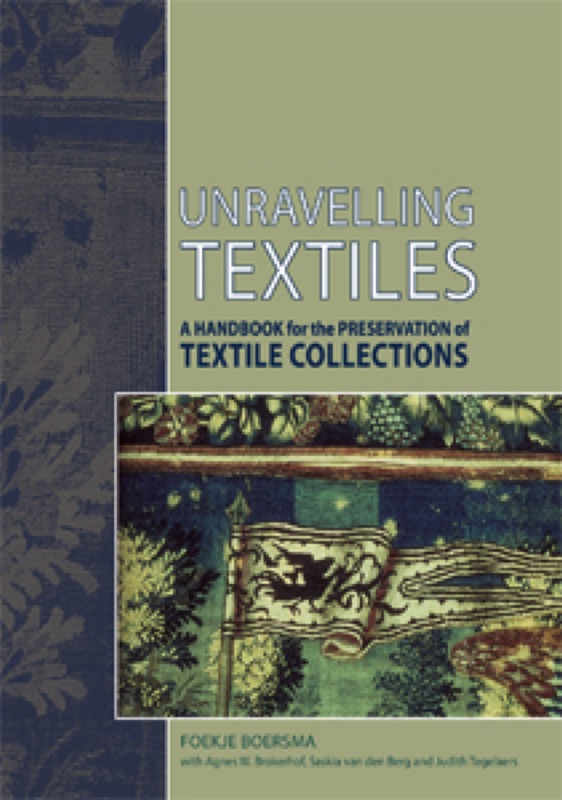This book (first published in the Netherlands as Op de keper beschouwd. Handboek voor het behoud van textielcollecties), sets out to present the basic information necessary for the professional safekeeping of textile collections.
Aimed at curators and owners of textile collections, collection management staff, conservators and conservation students, it contains:
-An overview of the most common textile fibres, production processes and techniques of decoration.
-A description of the degradation processes of textiles and the effects of temperature, relative humidity, air pollution and light on textiles.
-Discussions on the storage, transit and exhibition of textiles and materials which can safely be used with textiles.
-Guidance for documentation, conservation and restoration, and collection management strategies.
This is a digital reprint of the original hardback edition, ISBN: 1873132646
Preface
Introduction
Acknowledgements
Materials
Fibres in general (polymers)
Classification
The chemistry and physics of polymers
Cellulose
Proteins
Vegetable fibres
Flax/linen
Cotton
Animal fibres
Wool/hair
Silk
Man-made fibres
Semi-synthetic fibres
Synthetic fibres
Morphology
Other synthetic fibres made from inorganic material
Textile techniques
Spinning
Weaving
Binding systems
Tapestries
Other techniques
Decorative techniques
Dyeing and printing textiles
Natural dyes
Synthetic dyes
Textile finishes/after treatments
Degradation of textiles
Natural decay of cellulose
Oxidation
Hydrolysis
Cross-linking
Influence of environmental circumstances
Natural decay of proteins
Photodegradation
Hydrolysis
Influence of environmental circumstances
Natural decay of other fibre material
Physical-mechanical processes
Response to moisture
Response to mechanical forces
Response to tension
Intrinsic decay
Other factors
Identifying degradation
The museum environment
The properties of the environment
Temperature
Relative humidity
Air pollution
Measuring and recording the museum environment
The control of environmental conditions
Division into zones
Conditioning of the environment
Summary
Appendix
Psychrometric chart
Materials and their equilibrium moisture content (EMC)
The effect of organic materials on the changes in the indoor climate
Light
Introduction
Electromagnetic spectrum; wavelength
Light intensity, luminance and reflection
Damage
Measuring devices
Lux meter
UV meter
Blue wool standard
LightCheck strips
Visible light
Damage to materials
Light sources
Measures to reduce light levels
UV radiation
Damage to materials
Light sources
Measures to filter out UV radiation
Infrared radiation
Damage to materials
Light sources
Measures to eliminate IR radiation
Light sources
Fibre optics
Energy efficiency
Presenting a textile collection
Lighting design
Recent developments
Insects and fungi in textile collections
Insects
Characteristics
Development
Requirements
Insects in textile collections
Fungi
Fungi in textile collections
Characteristics and development
Requirements
Damage caused by fungi
Active or not?
Integrated pest management
The five steps of IPM
Detection
Disinfestation and disinfection methods
Insects
Fungi
Other methods
Choosing the most appropriate disinfestation method
Storage
Storage facilities
General guidelines
Preventive measures
Quarantine
Storage systems and materials
Suitable systems
Suitable materials
Access to and use of storage facilities
Objects in storage
Location of collection(s) in museum buildings
Storage of textiles
Large and/or long two-dimensional textiles
Small two-dimensional textiles
Flat textiles with pile
Flat, composite objects
Three-dimensional textiles
Three-dimensional objects
Transportation
Determining the object's fragility
Risk analysis of the transportation route
Means of external transportation
Optimising the object and/or route
Determining the necessary protection and designing the packaging
Packing the object
Transporting/couriering
Unpacking and checking the object
Evaluate and improve approach
Textiles on display
Temporary exhibitions
Textiles as part of a (semi-)permanent exhibition
Textiles in interiors
Light
Environment
Abrasion
Replicas
Seasonal closure
Showcases or open display?
Climatic conditions and showcases
Light and showcases
Exhibiting textiles
Large and/or long two-dimensional textiles
Small two-dimensional textiles
Flat textiles with pile
Flat, composite objects
Three-dimensional textiles
Three-dimensional objects
Appendix
Materials for making a padded, fabric-covered board
Instructions for making a padded, fabric-covered board
Materials for conservation
Research
Products
Sheet materials for making supports
Materials used in making supports
Adhesives and tapes
Barrier foils
Packaging material
Personal safety
Fabrics, non-wovens and fabric tapes
Other materials
Conservation and restoration
The history of conservation
Terminology
The textile conservator
Ethical code
Contracting out conservation work
Defining tasks
Mechanical cleaning of textiles
The removal of dust
Documentation
The documentary task: registration and documentation of a museum collection
Computerisation
Objects entering the collection
Registration of objects entering a collection
The sending out of objects
The acquisition of objects
Describing the object
Location control and the moving of objects
Numbering of textile objects
Condition reports
Photography
Appendix
Form of entry
Form of return
Collection management
Collection plan
Maintenance plan
The condition report
Disaster plan
Textile calamities and first aid
Water damage
Glossary
Bibliography
Index
